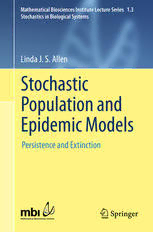Table Of ContentMathematical Biosciences Institute Lecture Series 1.3
Stochastics in Biological Systems
Linda J. S. Allen
Stochastic
Population and
Epidemic Models
Persistence and Extinction
MathematicalBiosciencesInstituteLectureSeries
The Mathematical Biosciences Institute (MBI) fosters innovation in the
application of mathematical, statistical and computational methods in
the resolution of significant problems in the biosciences, and encourages
the development of new areas in the mathematical sciences motivated by
important questions in the biosciences. To accomplish this mission, MBI
holds many week-long research workshops each year, trains postdoctoral
fellows,andsponsorsavarietyofeducationalprograms.
The MBI lecture series are readable up to date introductions into exciting
research areas that are inspired by annual programs at the MBI. The pur-
pose is to provide curricular materials that illustrate the applications of the
mathematical sciences to the life sciences. The collections are organized
as independent volumes, each one suitable for use as a module in standard
graduatecoursesinthemathematicalsciencesandwritteninastyleaccessi-
bletoresearchers,professionals,andgraduatestudentsinthemathematical
andbiologicalsciences.TheMBIlecturescanalsoserveasanintroduction
for researchers to recent and emerging subject areas in the mathematical
biosciences.
MartyGolubitsky,MichaelReed
MathematicalBiosciencesinstitute
Moreinformationaboutthisseriesathttp://www.springer.com/series/13083
MathematicalBiosciencesInstituteLectureSeries
Volume1.3:StochasticsinBiological Systems
Stochasticity is fundamental to biological systems. In some situations the
system can be treated as a large number of similar agents interacting in a ho-
mogeneously mixing environment, and so the dynamics are well-captured by
deterministic ordinary differential equations. However, in many situations, the
systemcanbedrivenbyasmallnumberofagentsorstronglyinfluencedbyan
environmentfluctuatinginspaceandtime.Forexample,fluctuationsarecritical
in the early stages of an epidemic; a small number of molecules may deter-
minethedirectionofcellularprocesses;changingclimatemayalterthebalance
among competing populations. Spatial models may be required when agents
aredistributedinspaceandinteractionsbetweenagentsarelocal.Systemscan
evolvetobecomemorerobustorco-evolveinresponsetocompetitiveorhost-
pathogen interactions. Consequently, models must allow agents to change and
interact in complex ways. Stochasticity increases the complexity of models in
someways,butmayalsosimplifyandsmoothresultsinotherways.
Volume1providesaseriesoflecturesbyinternationallywell-knownauthors
basedontheyearonStochasticsinBiologicalSystemswhichtookplaceat
theMBIin2011–2012.
MichaelReed,RichardDurrett
Editors
MathematicalBiosciencesInstituteLectureSeries
Volume1:StochasticsinBiological Systems
StochasticPopulationandEpidemicModels
LindaJ.S.Allen
StochasticAnalysisofBiochemicalSystems
DavidAnderson;ThomasG.Kurtz
StochasticModelsforStructuredPopulations
VincentBansaye;SylvieMe´le´ard
BranchingProcessModelsofCancer
RichardDurrett
StochasticNeuronModeling
PricillaGreenwood;LawrenceWard
TheMathematicsofIntracellularTransport
ScottMcKinley;PeterKramer
PopulationModelswithInteraction
EtiennePardoux
CorrelationsfromCoupledEnzymaticProcessing
RuthWilliams
Linda J.S. Allen
Stochastic Population
and Epidemic Models
Persistence and Extinction
123
LindaJ.S.Allen
DepartmentofMathematicsandStatistics
TexasTechUniversity
Lubbock,TX,USA
ISSN2364-2297 ISSN2364-2300 (electronic)
MathematicalBiosciencesInstituteLectureseries
ISBN978-3-319-21553-2 ISBN978-3-319-21554-9 (eBook)
DOI10.1007/978-3-319-21554-9
LibraryofCongressControlNumber:2015946862
MathematicsSubjectClassification(2010):60J85,92D25,92D30,92D40,34D20
SpringerChamHeidelbergNewYorkDordrechtLondon
©SpringerInternationalPublishingSwitzerland2015
Thisworkissubjecttocopyright.AllrightsarereservedbythePublisher,whetherthewholeorpartof
thematerialisconcerned,specificallytherightsoftranslation,reprinting,reuseofillustrations,recitation,
broadcasting,reproductiononmicrofilmsorinanyotherphysicalway,andtransmissionorinformation
storageandretrieval,electronicadaptation,computersoftware,orbysimilarordissimilarmethodology
nowknownorhereafterdeveloped.
Theuseofgeneraldescriptivenames,registerednames,trademarks,servicemarks,etc.inthispublication
doesnotimply,evenintheabsenceofaspecificstatement,thatsuchnamesareexemptfromtherelevant
protectivelawsandregulationsandthereforefreeforgeneraluse.
Thepublisher,theauthorsandtheeditorsaresafetoassumethattheadviceandinformationinthisbook
arebelievedtobetrueandaccurateatthedateofpublication.Neitherthepublishernortheauthorsor
theeditorsgiveawarranty,expressorimplied,withrespecttothematerialcontainedhereinorforany
errorsoromissionsthatmayhavebeenmade.
Printedonacid-freepaper
SpringerInternationalPublishingAGSwitzerlandispartofSpringerScience+BusinessMedia(www.
springer.com)
Preface
Theintentofthismonographistointroducegraduatestudentstobranchingprocess
applicationsofpopulationsandepidemics.Deterministicmodelsofpopulationsand
epidemicsarewellknowninthescientificliteratureandtheyprovideusefulinfor-
mation on the dynamics when population and epidemic sizes are large. However,
when sizes are not large, stochastic models and theory are required, for example,
to estimate the probability of extinction. The stochastic theory of branching pro-
cesses has a long history and can be used as a tool in understanding extinction in
manysituations.Inthemid19thcentury,GaltonandWatsonintroducedbranching
processes to explain the extinction of family names. Whittle applied the theory in
1955 to an SIR epidemic to estimate the probability of a major outbreak. In this
brief monograph, a summary is presented of single-type and multi-type branching
process theory. This theory is used to estimate the probability of ultimate extinc-
tion in some classic population and epidemic models such as SEIR epidemic and
logisticgrowth,andsomenewapplicationsofspeciesinvasionsandspatialspread
of disease. Some MatLaB programs of stochastic simulations are provided in the
Appendix, and some references are given to additional applications of branching
processestopopulationsandepidemics.
I thank Rick Durrett and Mike Reed for the invitation to develop these lecture
notes as part of the Mathematical Biosciences Institute Graduate Lecture Series,
Volume 1: Stochastics in Biological Systems. In addition, I thank Edward Allen,
TexasTechUniversity,whoprovidedvaluablefeedbackonChapter4,andananony-
mousreviewerwhoprovidedsuggestionsandcorrectionsonChapters1–4.Iespe-
ciallythanktheeditorialandproductionstaffatSpringer.
Lubbock,TX,USA LindaJ.S.Allen
vii
Contents
1 Continuous-TimeandDiscrete-StateBranchingProcesses .......... 1
1.1 Introduction ............................................... 1
1.2 Single-TypeBranchingProcesses ............................. 1
1.2.1 Birth-Death ......................................... 5
1.3 Multi-TypeBranchingProcesses.............................. 7
1.3.1 Birth-Death-Dispersal ................................ 9
1.4 Summary ................................................. 12
2 ApplicationsofSingle-TypeBranchingProcesses .................. 13
2.1 Introduction ............................................... 13
2.2 SIRSEpidemic ............................................ 13
2.3 SpeciesInvasion ........................................... 17
2.4 Summary ................................................. 20
3 ApplicationsofMulti-TypeBranchingProcesses................... 21
3.1 Introduction ............................................... 21
3.2 SEIREpidemic ............................................ 22
3.3 EpidemicDispersal......................................... 24
3.4 Summary ................................................. 27
4 Continuous-TimeandContinuous-StateBranchingProcesses ....... 29
4.1 Introduction ............................................... 29
4.2 Single-TypeBranchingProcesses ............................. 30
4.3 Applications............................................... 32
4.3.1 LogisticGrowth ..................................... 32
4.3.2 SIREpidemic ....................................... 34
4.4 Summary ................................................. 34
ix

